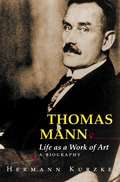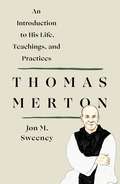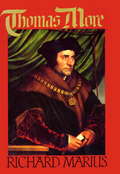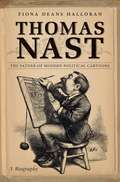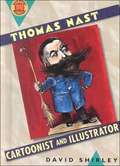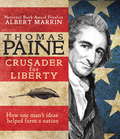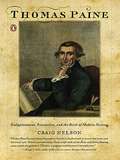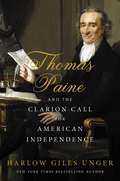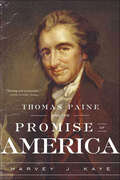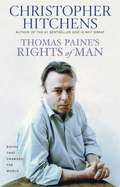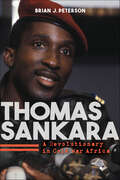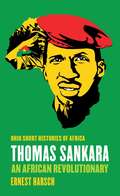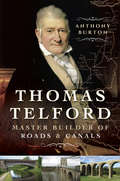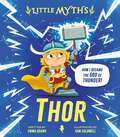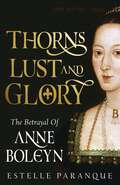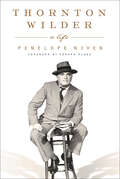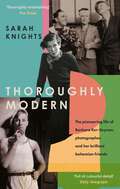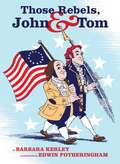- Table View
- List View
Thomas Mann: Life as a Work of Art. A Biography
by Hermann KurzkeThis vivid, sometimes tragic, and often humorous literary biography brings to life as never before the extraordinary talent and complex person who was Thomas Mann. Engrossing vignettes enable us to enter Mann's life and work from unique angles. We meet the difficult, even unsavory private man: hypochondriac and nervous, narcissistic and vainglorious, isolated and greedy for love, shy and often ungenerous. But we are also introduced to a man who lived an eventful life, was capable of great kindness, loved dogs, doted on his daughters, and listened to Jack Benny. We experience Mann's tragedy as the quintessential German forced by the rise of National Socialism first into inner exile and then into real exile in Switzerland, Princeton, and California. His letters from this time reveal the torment that exile represented for a writer whose work, indeed whose very self, was inextricably bound up with the German language. The book provides fresh and sometimes startling insights into both famous and little-known episodes in Mann's life and into his writing--the only realm in which he ever felt free. It shows how love, death, religion, and politics were not merely themes in Buddenbrooks, The Magic Mountain, and other works, but were woven into the fabric of his existence and preoccupied him unrelentingly. It also teases out what is known about what Mann considered his celibate homoeroticism and what others have labeled closeted homosexuality. In particular, we learn about his affection for the young man who inspired the character of Tadzio in Death in Venice. And, against the unfocused accusations of anti-Semitism that have been leveled at Mann, the book examines in human detail his relationships with Jewish writers, friends, and family members. This is the richest available portrait of Thomas Mann as man and writer--the place to start for anyone wanting to know anything about his life, work, or times.
Thomas Merton: Lessons From The Life And Writings Of Thomas Merton
by Jon M. SweeneyAn introduction to the spiritual legacy of Thomas Merton Thomas Merton was a Trappist monk and one of the most influential spiritual figures of the 20th century. His writing on contemplation, monastic life, mysticism, poetry, and social issues have influenced generations and his legacy of interfaith understanding and social justice endures to this day. Thomas Merton: An Introduction to His Life, Teachings, and Practices offers an exploration of Merton as a monk, as a writer, and as a human being. Author Jon M. Sweeney delves into Merton’s life and ideas with an appreciation for his work and a deep understanding of the spiritual depth that it contains. Thomas Merton offers a unique view of the popular and sometimes controversial monk, braiding together his thoughts and practices with the reality of his life to create a full portrait of a pivotal figure. The Merton revealed in its pages is a source of inspiration and insight for those wrestling with questions of faith and spirituality. At its core, the book is about the search for wholeness—a search Merton undertook himself throughout his lifetime and one readers can also embark on as they draw inspiration and guidance from his life.
Thomas More
by Richard MariusOver the centuries, biographers of Thomas More have always praised him and made him an example for their own times. He was a man for all seasons. This Tudor prelate and Lord Chancellor of England shared human qualities identifiable in all ages-pride, love, ambition, generosity, hypocrisy, and greed. He was less than common because he was witty and a great storyteller-the best between Chaucer and Shakespeare. Truly, he was a Renaissance man with the contradictions such praise imposes on a towering figure. In Richard Marius's authoritative and engaging portrait, Sir Thomas More, the martyr and brilliant public figure, is a lesson for our season.
Thomas Nast
by Fiona Deans HalloranThomas Nast (1840-1902), the founding father of American political cartooning, is perhaps best known for his cartoons portraying political parties as the Democratic donkey and the Republican elephant. Nast's legacy also includes a trove of other political cartoons, his successful attack on the machine politics of Tammany Hall in 1871, and his wildly popular illustrations of Santa Claus for Harper's Weekly magazine. Throughout his career, his drawings provided a pointed critique that forced readers to confront the contradictions around them. In this thoroughgoing and lively biography, Fiona Deans Halloran focuses not just on Nast's political cartoons for Harper's but also on his place within the complexities of Gilded Age politics and highlights the many contradictions in his own life: he was an immigrant who attacked immigrant communities, a supporter of civil rights who portrayed black men as foolish children in need of guidance, and an enemy of corruption and hypocrisy who idolized Ulysses S. Grant. He was a man with powerful friends, including Mark Twain, and powerful enemies, including William M. "Boss" Tweed. Halloran interprets Nast's work, explores his motivations and ideals, and illuminates Nast's lasting legacy on American political culture.
Thomas Nast: Cartoonist and Illustrator
by David ShirleyDescribes the life of the young German immigrant who became a noted illustrator of magazines and a political cartoonist.
Thomas Paine
by Albert MarrinFrom National Book Award finalist Albert Marrin comes a compelling look at the life and impact of Thomas Paine and the profound power of ideas.Uneducated as a boy, Thomas Paine grew up to become one of the most influential writers of the 18th century. He brought the world Common Sense, Rights of Man, and The Age of Reason; simply written, verbal battles against political, civil, and religious ignorance. Dubbed 'The Father of the American Revolution', Paine began his written reign by fervently proposing the idea of American independence from Great Britain, where he lived before emigrating to the United States in his thirties. As one historical event led to another, Paine continued to divulge his ideas to the public, risking his reputation and even his life. Award-winning author Albert Marrin illustrates the hardships and significance of a man's beliefs and its affects on our nation in a way that all ages can comprehend.From the Hardcover edition.
Thomas Paine
by Craig NelsonA fresh new look at the Enlightenment intellectual who became the most controversial of America's founding fathers Despite his being a founder of both the United States and the French Republic, the creator of the phrase "United States of America," and the author of Common Sense, Thomas Paine is the least well known of America's founding fathers. This edifying biography by Craig Nelson traces Paine's path from his years as a London mechanic, through his emergence as the voice of revolutionary fervor on two continents, to his final days in the throes of dementia. By acquainting us as never before with this complex and combative genius, Nelson rescues a giant from obscurity-and gives us a fascinating work of history.
Thomas Paine and the Clarion Call for American Independence
by Harlow Giles UngerFrom New York Times bestselling author and Founding Fathers' biographer Harlow Giles Unger comes the astonishing biography of the man whose pen set America ablaze, inspiring its revolution, and whose ideas about reason and religion continue to try men's souls. Thomas Paine's words were like no others in history: they leaped off the page, inspiring readers to change their lives, their governments, their kings, and even their gods. In an age when spoken and written words were the only forms of communication, Paine's aroused men to action like no one else. The most widely read political writer of his generation, he proved to be more than a century ahead of his time, conceiving and demanding unheard-of social reforms that are now integral elements of modern republican societies. Among them were government subsidies for the poor, universal housing and education, pre- and post-natal care for women, and universal social security. An Englishman who emigrated to the American colonies, he formed close friendships with Benjamin Franklin, Thomas Jefferson, and James Madison, and his ideas helped shape the Declaration of Independence and the Bill of Rights. However, the world turned against Paine in his later years. While his earlier works, Common Sense and Rights of Man, attacked the political and social status quo here on earth, The Age of Reason attacked the status quo of the hereafter. Former friends shunned him, and the man America had hailed as the muse of the American Revolution died alone and forgotten. Packed with action and intrigue, soldiers and spies, politics and perfidy, Unger's Thomas Paine is a much-needed new look at a defining figure.
Thomas Paine and the Dangerous Word (Hyperion Picture Book (eBook))
by Sarah Jane Marsh"The mind once enlightened cannot again become dark."As an English corset-maker's son, Thomas Paine was expected to spend his life sewing women's underwear. But as a teenager, Thomas dared to change his destiny, enduring years of struggle until a meeting with Benjamin Franklin brought Thomas to America in 1774-and into the American Revolution. Within fourteen months, Thomas would unleash the persuasive power of the written word in Common Sense-a brash wake-up call that rallied the American people to declare independence against the mightiest empire in the world. This fascinating and extensively researched biography, based on numerous primary sources, will immerse readers in Thomas Paine's inspiring journey of courage, failure, and resilience that led a penniless immigrant to change the world with his words.
Thomas Paine and the Idea of Human Rights
by Robert LambThomas Paine is a legendary Anglo-American political icon: a passionate, plain-speaking, relentlessly controversial, revolutionary campaigner, whose writings captured the zeitgeist of the two most significant political events of the eighteenth century, the American and French Revolutions. Though widely acknowledged by historians as one of the most important and influential pamphleteers, rhetoricians, polemicists and political actors of his age, the philosophical content of his writing has nevertheless been almost entirely ignored. This book takes Paine's political philosophy seriously. It explores his views concerning a number of perennial issues in modern political thought including the grounds for, and limits to, political obligation; the nature of representative democracy; the justification for private property ownership; international relations; and the relationship between secular liberalism and religion. It shows that Paine offers a historically and philosophically distinct account of liberalism and a theory of human rights that is a progenitor of our own.
Thomas Paine and the Promise of America: A History & Biography
by Harvey J. KayeThis acclaimed biography “provides the most comprehensive assessment yet of [the Founding Father’s] controversial reputation” (Joseph J. Ellis, The New York Times Book Review).After leaving London for Philadelphia in 1774, Thomas Paine became one of the most influential political writers of the modern world and the greatest radical of a radical age. Through writings like Common Sense, he not only turned America’s colonial rebellion into a revolutionary war but, as Harvey J. Kaye demonstrates, articulated an American identity charged with exceptional purpose and promise.Thomas Paine and the Promise of America fiercely traces the revolutionary spirit that runs through American history—and demonstrates how that spirit is rooted in Paine’s legacy. With passion and wit, Kaye shows how Paine turned Americans into radicals—and how we have remained radicals ever since.
Thomas Paine's Rights of Man: A Biography
by Christopher HitchensThomas Paine's "Rights of Man" has been celebrated, criticized, maligned, suppressed, and co-opted, but Hitchens marvels at its forethought and revels in its contentiousness. In this book, he demonstrates how Paine's book forms the philosophical cornerstone of the U.S.
Thomas Sankara: A Revolutionary in Cold War Africa
by Brian J. PetersonThomas Sankara: A Revolutionary in Cold War Africa offers the first complete biography in English of the dynamic revolutionary leader from Burkina Faso, Thomas Sankara. Coming to power in 1983, Sankara set his sights on combating social injustice, poverty, and corruption in his country, fighting for women's rights, direct forms of democracy, economic sovereignty, and environmental justice. Drawing on government archival sources and over a hundred interviews with Sankara's family members, friends, and closest revolutionary colleagues, Brian J. Peterson details Sankara's political career and rise to power, as well as his assassination at age 37 in 1987, in a plot led by his close friend Blaise Compaoré. Thomas Sankara: A Revolutionary in Cold War Africa offers a unique, critical appraisal of Sankara and explores why he generated such enthusiasm and hope in Burkina Faso and beyond, why he was such a polarizing figure, how his rivals seized power from him, and why T-shirts sporting his image still appear on the streets today.
Thomas Sankara: An African Revolutionary (Ohio Short Histories Of Africa)
by Ernest HarschThomas Sankara, often called the African Che Guevara, was president of Burkina Faso, one of the poorest countries in Africa, until his assassination during the military coup that brought down his government. Although his tenure in office was relatively short, Sankara left an indelible mark on his country's history and development. An avowed Marxist, he outspokenly asserted his country's independence from France and other Western powers while at the same time seeking to build a genuine pan-African unity. <p><p> Ernest Harsch traces Sankara's life from his student days to his recruitment into the military, early political awakening, and increasing dismay with his country's extreme poverty and political corruption. As he rose to higher leadership positions, he used those offices to mobilize people for change and to counter the influence of the old, corrupt elites. Sankara and his colleagues initiated economic and social policies that shifted away from dependence on foreign aid and toward a greater use of the country's own resources to build schools, health clinics, and public works. Although Sankara's sweeping vision and practical reforms won him admirers both in Burkina Faso and across Africa, a combination of domestic opposition groups and factions within his own government and the army finally led to his assassination in 1987. <p> This is the first English-language book to tell the story of Sankara's life and struggles, drawing on the author's extensive firsthand research and reporting on Burkina Faso, including interviews with the late leader. Decades after his death, Sankara remains an inspiration to young people throughout Africa for his integrity, idealism, and dedication to independence and self-determination.
Thomas Telford: Master Builder of Roads & Canals
by Anthony BurtonThomas Telford's life was extraordinary: born in the Lowlands of Scotland, where his father worked as a shepherd, he ended his days as the most revered engineer in the world, known punningly as The Colossus of Roads. He was responsible for some of the great works of the age, such as the suspension bridge across the Menai Straits and the mighty Pontcysyllte aqueduct. He built some of the best roads seen in Britain since the days of the Romans and constructed the great Caledonian Canal, designed to take ships across Scotland from coast to coast. He did as much as anyone to turn engineering into a profession and was the first President of the newly formed Institution of Civil Engineers. All this was achieved by a man who started work as a boy apprentice to a stonemason. rn He was always intensely proud of his homeland and was to be in charge of an immense programme of reconstruction for the Highlands that included building everything from roads to harbours and even designing churches. He was unquestionably one of Britain's finest engineers, able to take his place alongside giants such as Brunel. He was also a man of culture, even though he had only a rudimentary education. As a mason in his early days he had worked alongside some of the greatest architects of the day, such as William Chambers and Robert Adams, and when he was appointed County Surveyor for Shropshire early in his career, he had the opportunity to practice those skills himself, designing two imposing churches in the county and overseeing the renovation of Shrewsbury Castle. Even as a boy, he had developed a love of literature and throughout his life wrote poetry and became a close friend of the Poet Laureate, Robert Southey. He was a man of many talents, who rose to the very top of his profession but never forgot his roots: he kept his old masons' tools with him to the end of his days. rn There are few official monuments to this great man, but he has no need of them: the true monuments are the structures that he left behind that speak of a man who brought about a revolution in transport and civil engineering.
Thor (Little Myths #1)
by Emma AdamsMost people know Thor for being the super strong God of Thunder who could control lightning and rode around on a magical chariot pulled by goats. But once upon a time, Thor was just a little boy. Sure, he was the son of an almighty god, and he was a ferocious warrior, but in lots of other ways he was just like you. He liked midnight feasts, playing games and he had a really annoying friend. But he grew up, he grew stronger, he found a hammer and he had all sorts of adventures. This is his story.Packed with facts from the Norse mythology and graphic art panels, Little Myths is the perfect series for mythology-mad kids.
Thoreau at Walden (The Center for Cartoon Studies Presents)
by John Porcellino"I am convinced, both by faith and experience, that to maintain one's self on this earth is not a hardship, but a pastime, if we will live simply and wisely." So said Henry David Thoreau in 1845 when he began his famous experiment of living by Walden Pond. In this graphic masterpiece, John Porcellino uses only the words of Thoreau himself to tell the story of those two years off the beaten track. The pared-down text focuses on Thoreau's most profound ideas, and Porcellino's fresh, simple pictures bring the philosopher's sojourn at Walden to cinematic life. For readers who know Walden intimately, this graphic treatment will provide a vivid new interpretation of Thoreau's story. For those who have never read (or never completed!) the original, it presents a contemporary look at a few brave words to live by.
Thorns, Lust, and Glory: The Betrayal of Anne Boleyn
by Estelle ParanqueIn this groundbreaking biography of Queen Anne Boleyn, learn how the ill-fated second wife of Renaissance England's Henry XVIII met her downfall–and how she came to be so vilified and misunderstood. Anne Boleyn has mesmerized the general public for centuries. Her tragic execution at the Tower of London on the 19th of May, 1536—orchestrated by her own husband—never ceases to intrigue. While many stories of Anne&’s downfall have been told, few have truly traced the origins of her grim fate. In Thorns, Lust, and Glory, Estelle Paranque takes us back to where it all started: to France, where Anne learned the lessons that would set her on the path to becoming one of England's most infamous queens. A fascinating new perspective on Tudor history's most enduring story, Thorns, Lust, and Glory is an unmissable account of a queen on the edge.
Thornton Wilder: A Life
by Penelope NivenThe definitive biography of the great American playwright: a “fine-grained, sympathetic portrait” with a foreword by Edward Albee (The New York Times).Thornton Wilder—three-time Pulitzer Prize winner, creator of such enduring stage works as Our Town and The Skin of Our Teeth, and beloved novels like Bridge of San Luis Ray and Theophilus North—was much more than a pivotal figure in twentieth century American theater and literature. He was also a traveler, a teacher, a scholar, a soldier, an outspoken citizen, and a complex, intensely private man. In Thornton Wilder: A Life, biographer Penelope Niven pulls back the curtain to present a fascinating portrait one of America's greatest literary icons. With unprecedented access to Wilder's papers, including his family's private journals and records, Niven shows the many sides of this multifaceted man, including his relationship to his two brilliant parents, four gifted siblings, and the specter of his twin brother lost at birth.“Comprehensive and wisely fashioned. . . . A splendid and long needed work.” —Edward Albee, playwright
Thoroughly Modern: The pioneering life of Barbara Ker-Seymer, photographer, and her brilliant Bohemian friends
by Sarah KnightsThe life of pioneering photographer Barbara Ker-Seymer'I just called myself Ker-Seymer Photographs,' Barbara said. 'I didn't think it was necessary to have your sex displayed on the photographs.' Vivacious, sassy, out to have fun, Ker-Seymer was committed to independence.One of a handful of outstanding British photographers of her generation, Ker-Seymer's work defined a talented, forward-looking network of artists, dancers, writers, actors and musicians, all of whom flocked to her Bond Street studio. Among her sitters were Evelyn Waugh, Margot Fonteyn, Cyril Connolly, Jean Cocteau and Vita Sackville-West. Barbara Ker-Seymer (1905-1993) disdained lucrative 'society' portraits in favour of unfussy 'modern' images. Her work was widely admired by her peers, among them, Man Ray and Jean Cocteau. Her images as a gossip-column photojournalist for Harper's Bazaar were the go-to representations of the aristocracy and Bright Young Things at play. Yet as both a studio portraitist and a photojournalist, she broke with convention.Equally unconventional in her personal life, Ker-Seymer was prefigurative in the way she lived her life as a bisexual woman and in her contempt for racism, misogyny and homophobia. Fiercely independent, for much of her life she rejected the idea of family, preferring her wide set of creative friends, with the artist Edward Burra, ballet dancer William 'Billy' Chappell and choreographer Frederick Ashton at its core. Today, Ker-Seymer's photographs are known for whom they represent, rather than the face behind the camera, an irony underpinned by the misattribution of some of her most daring images to Cecil Beaton. Yet her intelligence, sparkle, wit and genius enabled her to link arms with the surrealists, the Bloomsbury Group, the Bright Young Things and, most gloriously, the worlds of theatre, cabaret and jazz. With unprecedented access to private archives and hitherto unseen material, Sarah Knights brings Barbara Ker-Seymer and her brilliant bohemian friends vividly to life.Praise for Sarah Knights' Bloomsbury's Outsider: A Life of David Garnett:'Perceptive... sympathetic, thorough and witty' Francesca Wade, Telegraph'Delightful read... exceedingly well-researched' DJ Taylor, Guardian'Magisterial biography' Roger Lewis, The Times'Wonderful' Claire Harman, Evening Standard 'Books of the Year'
Thoroughly Modern: The pioneering life of Barbara Ker-Seymer, photographer, and her brilliant Bohemian friends
by Sarah KnightsThe life of pioneering photographer Barbara Ker-Seymer'I just called myself Ker-Seymer Photographs,' Barbara said. 'I didn't think it was necessary to have your sex displayed on the photographs.' Vivacious, sassy, out to have fun, Ker-Seymer was committed to independence.One of a handful of outstanding British photographers of her generation, Ker-Seymer's work defined a talented, forward-looking network of artists, dancers, writers, actors and musicians, all of whom flocked to her Bond Street studio. Among her sitters were Evelyn Waugh, Margot Fonteyn, Cyril Connolly, Jean Cocteau and Vita Sackville-West. Barbara Ker-Seymer (1905-1993) disdained lucrative 'society' portraits in favour of unfussy 'modern' images. Her work was widely admired by her peers, among them, Man Ray and Jean Cocteau. Her images as a gossip-column photojournalist for Harper's Bazaar were the go-to representations of the aristocracy and Bright Young Things at play. Yet as both a studio portraitist and a photojournalist, she broke with convention.Equally unconventional in her personal life, Ker-Seymer was prefigurative in the way she lived her life as a bisexual woman and in her contempt for racism, misogyny and homophobia. Fiercely independent, for much of her life she rejected the idea of family, preferring her wide set of creative friends, with the artist Edward Burra, ballet dancer William 'Billy' Chappell and choreographer Frederick Ashton at its core. Today, Ker-Seymer's photographs are known for whom they represent, rather than the face behind the camera, an irony underpinned by the misattribution of some of her most daring images to Cecil Beaton. Yet her intelligence, sparkle, wit and genius enabled her to link arms with the surrealists, the Bloomsbury Group, the Bright Young Things and, most gloriously, the worlds of theatre, cabaret and jazz. With unprecedented access to private archives and hitherto unseen material, Sarah Knights brings Barbara Ker-Seymer and her brilliant bohemian friends vividly to life.Praise for Sarah Knights' Bloomsbury's Outsider: A Life of David Garnett:'Perceptive... sympathetic, thorough and witty' Francesca Wade, Telegraph'Delightful read... exceedingly well-researched' DJ Taylor, Guardian'Magisterial biography' Roger Lewis, The Times'Wonderful' Claire Harman, Evening Standard 'Books of the Year'
Those Paris Days: With The World At The Crossroads
by Dr Samuel N. WatsonIn the volume the former Dean of the American Cathedral of the Holy Trinity in Paris Samuel N. Watson recounts his experiences across America and Europe in his many years in the priesthood. Perhaps of particular interest are his reminiscences of the First World War, from which period the book takes its title and forms the majority of the pages, the Dean was a well-known and well respected pillar of the expatriate American community in Paris. Through his contacts and by his charm and grace he organized a great deal of the aid effort that flowed through the Church during World War One. An interesting snapshot of the Great War from a different perspective than the many frontline accounts.
Those Rebels, John and Tom
by Barbara Kerley Edwin FotheringhamA brilliant portrait of two American heroes from the award-winning creators of The Extraordinary Mark Twain (According to Susy)! John Adams and Thomas Jefferson were very different. John Adams was short and stout. Thomas Jefferson was tall and lean. John was argumentative and blunt. Tom was soft-spoken and polite. John sometimes got along with almost no one. Tom got along with just about everyone. But these two very different gentlemen did have two things in common: They both cared deeply about the American colonies, and neither cared much for the British tyrant, King George. With their signature wit, impeccable research, and inventive presentation style, award winners Barbara Kerley and Edwin Fotheringham masterfully blend biography and history to create a brilliant portrait of two American heroes who bravely set aside their differences to join forces in the fight for our country's freedom.
